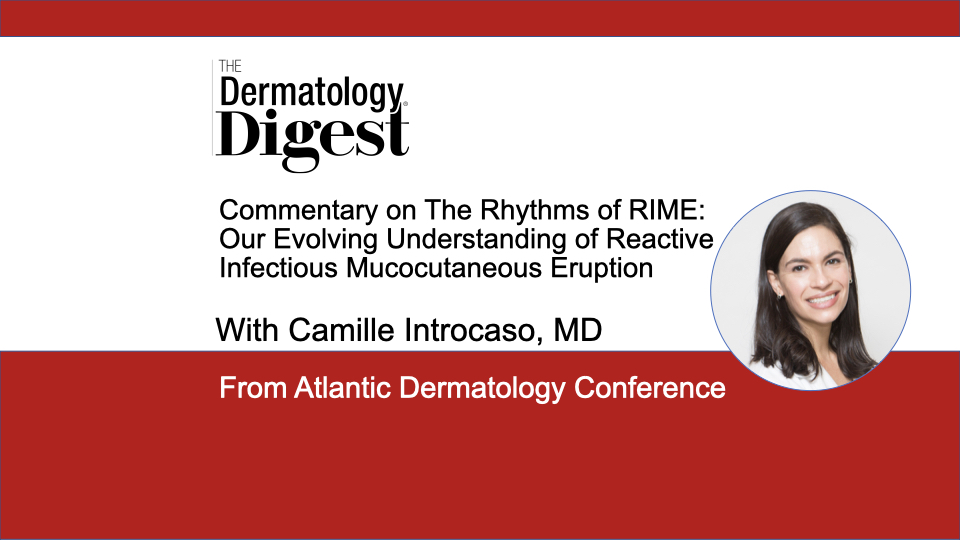Dr. Camille Introcaso discusses reactive infectious mucocutaneous eruption (RIME), including the term’s evolution, what RIME means to patients, and how to diagnose and treat it.
Camille Introcaso, MD, is Associate Professor of Medicine at Cooper Medical School of Rowan University, Camden, New Jersey
“RIME is an acronym for reactive infectious mucocutaneous eruption. This is a new term defined by Dr. Michele Ramien and colleagues in 2018 to distinguish patients who have erosive mucositis and cutaneous lesions caused by infection from patients whose condition is caused by drugs,” said Camille Introcaso, MD, who presented “The Rhythms of RIME: Our Evolving Understanding of Reactive Infectious Mucocutaneous Eruption,” at the Atlantic Dermatology Conference.1,2
RIME is characterized by four findings from a patient’s history, physical exam, and evaluation, according to Dr. Introcaso.
“First, patients have an erosive mucositis of two or more mucous membranes. Second, skin lesions might be absent entirely or there may be sparse vesicular bullous or targetoid skin lesions. Third, patients have evidence of an infectious trigger. Fourth, the patient has not taken a medicine that could have caused the eruption.”
“Very importantly, RIME is distinguished from drug-induced necrolysis,” said Dr. Introcaso.
Terms that dermatologists are familiar with, including erythema multiforme (EM) major, Stevens-Johnson syndrome (SJS), and toxic epidermal necrolysis (TEN), can be problematic because they have been used in the literature to describe a spectrum of often overlapping conditions with different causes and outcomes, according to Dr. Introcaso.
“We’re beginning to understand the differences in etiology, disease course, and management for patients previously described as EM major, SJS or TEN, and we’re finding our nomenclature to reflect those understandings is really important.”
The Relationship Between RIME and MIRM
RIME encompasses mycoplasma pneumoniae-induced rash and mucositis (MIRM), which Canavan and colleagues defined in 2015 as a specific entity of erosive mucositis and relatively mild cutaneous findings in patients with mycoplasma pneumoniae infection.3
“Once MIRM was defined and characterized, many physicians began to recognize that this syndrome was appearing in patients not just with Mycoplasma pneumoniae infection but in other respiratory illnesses. That prompted Ramien and colleagues to suggest this new term ‘reactive infectious mucocutaneous eruption,’ or RIME, which more accurately describes the spectrum of this condition,” said Dr. Introcaso.
Who Gets RIME and Why?
According to Dr. Introcaso, both bacterial and viral respiratory pathogens have been associated with RIME. These include not only Mycoplasma pneumoniae, but also Chlamydia pneumoniae, and group A streptococcal pharyngitis as bacterial causes. Viral causes of RIME include adenovirus, human metapneumovirus, parainfluenza virus, influenza virus types A and B, and recently there have been multiple reports of the SARS-CoV-2 virus being associated with RIME.
“There aren’t any large population-based studies to give us an incidence rate of RIME, but we do know that pediatric patients and younger adults are more represented in the few series that have been described. And there does seem to be a higher likelihood of men or boys being involved, with large case series describing between 54% to 62% of patients as male.”
RIME Sequelae
RIME has a number of consequences, according to Dr. Introcaso.
“Although the disease tends to have a mild course, there are infrequent long-term sequelae generally due to mucosal complications, including mucosal adhesions. There is really no significant mortality that has been reported.”
“However, a significant feature that has been reported with RIME is the chance for recurrence. That original 2015 review that described MIRM reported that about 8% of patients had previous episodes of similar rash or mucositis. There have also been multiple case reports of small series of patients with recurrent episodes, including some with many different infectious agents as causes of recurrence. There has been a small number of patients who have been reported to have as many as seven episodes in less than three years,” she said.
Treating RIME
There is no evidence to suggest RIME patients respond to prophylactic antibiotics, but they do respond to systemic steroids when the episodes occur, according to Dr. Introcaso.
“It’s important to counsel patients and families about this so they can recognize symptoms and seek appropriate care early in the course of their disease.”
When faced with a patient with RIME, dermatologists should think about treatment in three general areas, according to Dr. Introcaso.
- Supportive care
Patients need to have their pain controlled; be appropriately hydrated; and have appropriate topical medications and wound care. - Treatment
If a particular infection is found, it is appropriate to start antibiotic therapy—in particular, therapies for either chlamydia or mycoplasma pneumoniae. If appropriate, consider antiviral therapy, as well. Finally, consider immunomodulatory therapy.
Dr. Introcaso said she has treated her patients with prednisone or IVIg and some even with tumor necrosis factor (TNF)-alpha inhibitors. - Counseling
Patients and families do need to be counseled about recurrences of RIME, she said.
“There are still a lot of areas of study that need to be done for appropriate treatments for these patients,” she said.
Disclosure: Dr. Introcaso reports no conflicts of interest related to this topic.
References:
- Ramien ML, Bahubeshi A, Pope E et al.Redefining severe cutaneous reactions in children. Poster presented at the Society for Pediatric Dermatology 43rd Annual Meeting, 11-14 July 2018, Lake Tahoe, California.
- Ramien ML. Reactive infectious mucocutaneous eruption: Mycoplasma pneumoniae-induced rash and mucositis and other parainfectious eruptions. Clin Exp Dermatol. 2021;46(3):420-429. doi:10.1111/ced.14404.
- Canavan TN, Mathes EF, Frieden I, Shinkai K. Mycoplasma pneumoniae-induced rash and mucositis as a syndrome distinct from Stevens-Johnson syndrome and erythema multiforme: a systematic review. J Am Acad Dermatol. 2015 Feb;72(2):239-45. doi: 10.1016/j.jaad.2014.06.026. PMID: 25592340.


